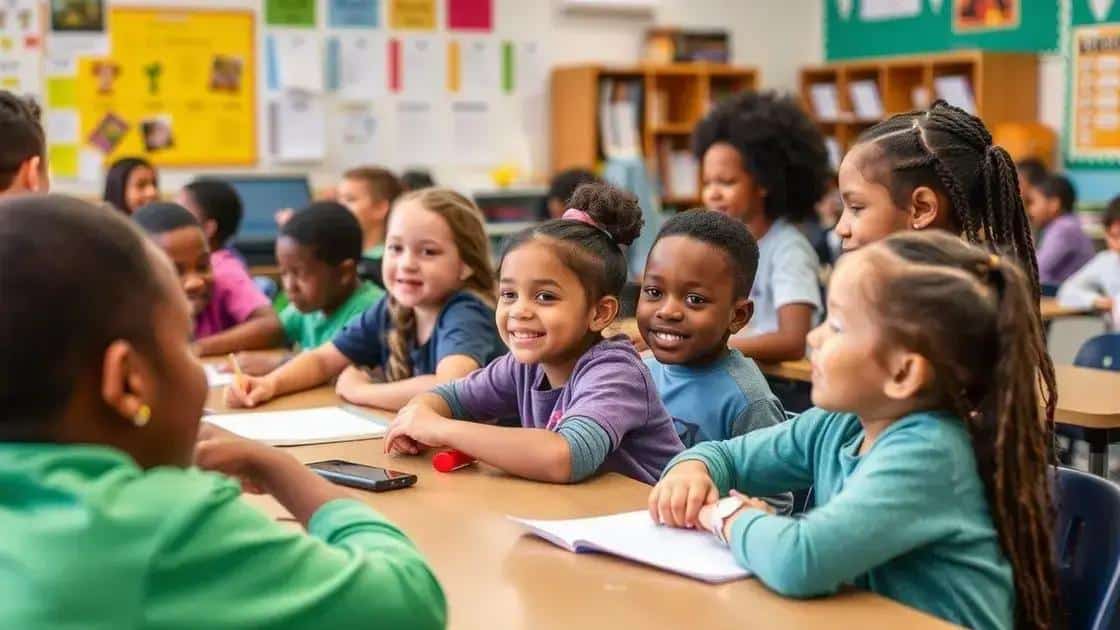Their special education law: a guide to understanding it

Their special education law ensures that students with disabilities receive personalized support and education, promoting inclusion and addressing diverse learning needs to enhance overall educational outcomes.
Their special education law plays a crucial role in shaping the educational landscape for students with disabilities. Understanding this law is essential for parents, educators, and advocates alike. In this article, we’ll delve into its main components and what they mean for educational practices.
Overview of their special education law
Overview of their special education law provides essential protections and guidelines for students with disabilities. This law focuses on ensuring that all children have access to quality education tailored to their unique needs. Understanding the basics of this legislation can help parents, teachers, and advocates navigate the educational landscape more effectively.
The main focus of this law is to ensure that students with disabilities receive an education that is both appropriate and equitable. It outlines the rights of these students and the responsibilities of schools. Let’s explore some key aspects.
Key Points of Their Special Education Law
First and foremost, schools are required to provide free appropriate public education (FAPE) to all eligible students. This means that educational services must be tailored to meet individual needs. Furthermore, schools must adhere to the principle of least restrictive environment (LRE). This guarantees that students are educated alongside their peers without disabilities whenever possible.
- Individualized Education Program (IEP): Each eligible child must have an IEP that outlines specific educational goals and services.
- Parental Involvement: Parents have a vital role in the development and implementation of their child’s IEP.
- Evaluation and Assessment: Regular assessments ensure that the educational plans meet the evolving needs of students.
- Transition Planning: IEPs should include plans for transitioning students from school to post-school activities.
In addition to these points, their special education law emphasizes the importance of collaboration between parents, educators, and specialists. This teamwork is essential for creating supportive learning environments that foster development and growth. As schools implement these laws, ongoing training and resources are crucial for educators to understand and meet their obligations.
By familiarizing themselves with their rights and the provisions of this law, families can advocate effectively for their children. It’s important to recognize that the law serves as a foundation for promoting inclusive education, allowing all students to thrive in their learning environments.
Key provisions of special education law
Key provisions of special education law establish the foundation for inclusive education, ensuring that students with disabilities receive appropriate support. These provisions outline the rights of students, the responsibilities of educational institutions, and essential practices for effective learning.
A central aspect of this law is the creation of the Individualized Education Program (IEP). The IEP is tailored for each student, focusing on their unique needs and defining specific goals. This document is developed collaboratively by educators, specialists, and families to create a supportive and effective learning environment.
Important Elements of the IEP
Within the IEP, there are several key components to consider:
- Current Performance: An assessment of the student’s strengths and challenges.
- Goals and Objectives: Specific, measurable goals that the student should achieve.
- Special Services: Any additional support needed, like speech therapy or counseling.
- Progress Monitoring: Regular updates on the student’s progress towards their goals.
In addition to IEPs, special education law mandates that students be educated in the least restrictive environment (LRE). This principle means that, whenever possible, students with disabilities should learn alongside their non-disabled peers. This inclusion fosters social interaction and enhances the overall educational experience.
Another critical provision is the requirement for schools to conduct evaluations to determine whether a student qualifies for special education services. These evaluations assess various areas of development and help identify the necessary accommodations for effective learning. Parents must be involved in these assessments and have a say in the educational planning process.
Moreover, the law emphasizes the need for parental involvement. Parents play a vital role in advocating for their child’s needs and collaborating with educators. By working together, families and schools can develop strategies that help students succeed.
Understanding these key provisions of special education law is essential for navigating the educational system. With proper knowledge, parents and educators can ensure that students with disabilities receive the support they deserve.
Impact on students with disabilities

Impact on students with disabilities is profound, shaping their educational experiences and future opportunities. Understanding this impact is essential for parents, educators, and advocates to create supportive environments.
Students with disabilities often face unique challenges in their education. These challenges can affect their learning, social interactions, and overall academic success. By addressing these challenges through appropriate support and services, we can enhance their educational experience.
Benefits of Special Education Law
One major impact of special education law is that it ensures students with disabilities have access to a free appropriate public education (FAPE). This means they receive individualized instruction that meets their specific needs. Students benefit from tailored academic programs that cater to their learning styles and abilities.
- Increased Access: More opportunities to participate in regular school programs.
- Improved Skills: Enhanced learning outcomes through specialized instruction.
- Boosted Confidence: Opportunities for success lead to higher self-esteem.
- Social Skills Development: Interaction with peers fosters social growth.
Moreover, the law promotes a collaborative approach involving teachers, parents, and specialists. This teamwork is vital for developing and implementing effective Individualized Education Programs (IEPs) that reflect each student’s unique needs. With this support, students can set and achieve realistic goals.
Having a strong support system allows students with disabilities to achieve more academically and socially. It equips them with essential skills that prepare them for future challenges, such as higher education or employment. These provisions help cultivate independence and self-advocacy.
Additionally, the presence of inclusive classrooms promotes understanding and acceptance among all students. By learning together, students without disabilities also benefit from diversity, which enriches the overall educational experience.
Challenges faced by schools
Challenges faced by schools in implementing their special education law are significant and varied. These difficulties can affect both educators and students, making it essential to understand the hurdles that schools encounter.
One of the biggest challenges schools face is the need for adequate resources. Many schools do not have enough funding to provide the necessary accommodations, support staff, or specialized materials that students with disabilities require. This can lead to disparities in educational opportunities.
Staff Training and Professional Development
Another critical issue is the lack of training for teachers and staff. Many educators need proper training on how to implement IEPs and manage classrooms that include students with diverse needs. Professional development is vital to equip teachers with the skills they need to support all learners effectively.
- Understanding Disabilities: Educators need comprehensive knowledge of different disabilities to serve students effectively.
- Behavior Management: Staff must be trained in strategies that promote positive behavior in diverse classrooms.
- Collaboration Skills: Teachers should develop the ability to work with specialists and families to create supportive environments.
Moreover, schools often grapple with balancing the needs of students with disabilities while meeting the demands of state and federal standards. This can create pressure on educators to find ways to ensure that all students meet academic benchmarks without compromising individual support.
In addition, schools may encounter difficulties in fostering parental involvement. Engaging families in the educational process can significantly impact student success. However, barriers such as communication gaps and socioeconomic challenges can hinder this partnership.
Lastly, managing diverse needs within the classroom can strain resources. Teachers must find ways to differentiate instruction and provide individualized support, which can be time-consuming and complex. Despite these challenges, many schools strive to create inclusive environments where every student can succeed.
Future trends in special education law
Future trends in special education law are shaping the landscape of education for students with disabilities. As society evolves, so does the understanding of diverse learning needs and the legal frameworks that support them.
One significant trend is the increasing emphasis on inclusive education. More schools are recognizing that educating students with disabilities alongside their peers without disabilities leads to better outcomes for all. This shift calls for a deeper commitment to training teachers and providing resources to ensure successful inclusion.
Technological Advancements
Another emerging trend is the integration of technology in special education. Tools like assistive technology and online learning platforms are making it easier for students to access resources and support tailored to their unique needs. These innovations help remove barriers to learning and promote greater engagement.
- Adaptive Learning Programs: Software that adjusts to individual learning paces.
- Virtual Reality (VR): Immersive experiences that enhance learning for students with disabilities.
- Mobile Applications: Tools that offer support and resources at students’ fingertips.
Moreover, there is a growing focus on mental health and social-emotional learning (SEL) in the context of special education. Recognizing the impact of emotional well-being on academic success has led schools to implement programs that address students’ mental health needs alongside their academic goals. This holistic approach is essential for fostering resilience and improving overall student outcomes.
Collaboration between schools, families, and community organizations is also on the rise. Parents are increasingly involved in advocating for their children’s rights and ensuring that schools meet their educational needs. This partnership can strengthen support systems and provide resources, leading to better outcomes for students.
As we look to the future, policies will likely continue to evolve to reflect these trends. Legislators are beginning to consider the dynamic needs of students with disabilities, which may result in more flexible guidelines that promote innovation and adaptability in educational settings.
In conclusion, understanding their special education law is vital for ensuring that students with disabilities receive the support they need to succeed. By promoting inclusive education, embracing technological advancements, and fostering strong collaboration between families and schools, we can create an environment where all students thrive. As we look to the future, continued advocacy and innovation will play key roles in enhancing educational opportunities for every learner.
FAQ – Frequently Asked Questions about Special Education Law
What is the purpose of special education law?
The purpose of special education law is to ensure that students with disabilities receive appropriate support and education tailored to their individual needs.
How does inclusive education benefit all students?
Inclusive education fosters an environment where all students learn from each other, enhancing social skills and promoting understanding of diversity.
What role do parents play in the special education process?
Parents are vital advocates for their children, collaborating with teachers and specialists to develop effective Individualized Education Programs (IEPs).
What are some challenges schools face in implementing special education law?
Schools often struggle with funding, staff training, and balancing the needs of all students while meeting educational standards.





